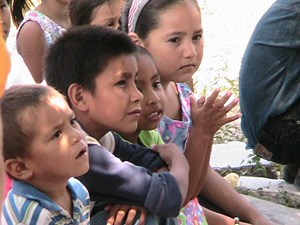 |
 |
 |
 News from Around the Americas | October 2006 News from Around the Americas | October 2006  
U.S. Border Town Split on Mexican School Kids
 Tim Gaynor - Reuters Tim Gaynor - Reuters


| | U.S. federal laws ensure that education is given to all school-age children, irrespective of their immigration status, although they have to prove residency in a school district in order to enroll. |
Each morning Antonio packs his school bag, hurries up his little sister and clambers into the family car for the daily run to school in this town in southern Arizona.

But for the eighth grader, like hundreds of other youngsters, the journey starts not in the dusty border community of Douglas, but south of the line in Agua Prieta in Sonora state in northern Mexico.

The children are Mexicans. Some come on foot through the border garret, clasping hands with their moms in a steady stream from early morning, while others pile into cars and station wagons and roll north over the international line.

Laughing and chattering in the chill morning air, they make their way to classrooms in the sleepy ranching and trade hub, like thousands of Mexican children the length of the border from California to south Texas.

No-one knows exactly how many cross from Mexico to classes each day. But officials in the Douglas education system say it could be anywhere from five percent in the ten public schools, to as much as three quarters at the city's three independent charter schools that also receive public funds.

The phenomenon cuts right to the heart of a heated debate in the United States about immigrants' access to benefits, becoming a political hot potato in the midterm elections, but welcomed by parents in poor Mexican towns south of the border.

"My children get a better, more formal education here, and they will get better opportunities as adults because of it," Antonio's mother Maria, a seatbelt factory worker from Agua Prieta, said in Spanish as she dropped her two children off at a middle school in Douglas.

"Nothing is more important to me than their future."

COMMUNITY DIVIDED

Arizona voters were to be asked to produce photo identification at the November 7 polls under a recent state law that sought to bar illegal immigrants from voting and receiving benefits. It was overruled this month by a U.S. federal appeals court.

Other controversial measures to deny services to illegal immigrants have been pushed in Colorado, Georgia and South Carolina, where several Republican and Democratic candidates are sparring over their records on the issue.

In Arizona's eighth district, which includes Douglas, both Democratic candidate Gabrielle Giffords and trailing Republican rival Randy Graf, have campaigned on the negative impact of undocumented immigrants on local education.

But in Douglas, where more than three quarters of the population of 16,000 is Hispanic, residents are divided over the rights and wrongs of Mexican children getting an education at a cost of $3,200 each to the state's tax payers.

"We tend to see ourselves as one community separated by an international boundary," Mayor Ray Borane told Reuters at his office, less than a mile from the steel fence marking the Mexico border.

"Almost everyone has family on the south side, and that has made people quite passive about the issue," he added.

But other residents of the sun-baked border town, where Mexican bandit turned revolutionary Pancho Villa once cantered his horse up the marble stairs of the local Gadsden Hotel, are dismissive.

"One community? That's just not true!" gun shop proprietor Lynn Kartchner told Reuters as he sat shooting the breeze with customers in his store just off the main strip.

"The fact is I can't go south to Mexico and get public services, so how is that fair?" he added.

CLASSROOM DEBATE

U.S. federal laws ensure that education is given to all school-age children, irrespective of their immigration status, although they have to prove residency in a school district in order to enroll.

Teachers in the Douglas school system, where Mexican parents register their children with a local guardian or use a false residential address to beat checks, are divided over the phenomenon.

"The students I have in class from Mexico often get involved in activities like the Science Olympiad, athletics and the swim team," said Ed Shisslak, who teaches science at Douglas High School.

"They tend to be motivated and work hard, and are not like some of the gang-bangers from Douglas who get into trouble," the 16-year veteran of the local public school system added.

Other teachers say the Mexican youngsters often have a lack of proficiency in English, which ties up more advanced children who have to mentor their weaker classmates.

"We love the kids and we can't blame the parents for wanting the best for them," said Michael Nava, who has taught in local schools for four decades.

"But on balance, they make it harder to meet state and national standards," he said.

The heated debate will rumble on in U.S. politics and the streets of Douglas long after the midterm elections. In the mean time children like Antonio say they are grateful for the opportunities their U.S. education will give them.

"When I grow up, I want to be a crime scene investigator," he says in perfect English, as the street outside his middle school filled up with cars with Sonora number plates.

"Coming to school here gives me that chance." | 
 | |
 |



